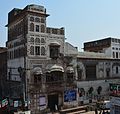Haveli of Nau Nihal Singh
نو نہال سنگھ حویلی | |
 The haveli's northwest façade is lavishly decorated. | |
 | |
| 31°34′46″N 74°18′39″E / 31.5795161°N 74.3109558°E | |
| Location | Lahore, Punjab, Pakistan |
|---|---|
| Type | Haveli |
The Haveli of Nau Nihal Singh (Urdu/Punjabi: نو نہال سنگھ حویلی), officially known as Government Victoria Girls' High School, is a haveli that houses a government school located in Lahore, Pakistan.[1] Dating from the Sikh era of the mid-19th century, the haveli is considered to be one of the finest examples of Sikh architecture in Lahore,[2] and is the only Sikh-era haveli that preserves its original ornamentation and architecture.[3]
Location
The haveli is located within the Walled City of Lahore, and is located near the Mori Gate in the southern half of the walled city. The haveli is also near the Bhatti Gate and Lohari Gate.
History
The haveli was built around the late 1830s for Kanwar Nau Nihal Singh,[4] by his grandfather and founder of the Sikh Empire, Maharaja Ranjit Singh.[3] The mansion was intended to be a personal residence for Nau Nihal Singh.[4] His grandmother, Maharani Datar Kaur, too played a considerable role in habilitation of the haveli.[5]
In 1841 Nau Nihal Singh's widow, Bibi Sahib Kaur Sahiba, delivered a stillborn son minutes before her own death. This prompted his mother, Maharani Chand Kaur to give up her claim on the golden throne of Punjab. The dowager Maharani retired to this haveli and received a pension of 900,000 rupees. However her enemies still saw her as a threat and she was battered to death with wooden pikes by her servants on 11 June 1842.[6]
The haveli has been used, since the British colonial era,[7] to house the Victoria Girls' High School.[8]
Architecture
The base of the haveli is rectangular in shape, with its entrance on the western side. The façade is divided into two sections, with the portion housing the haveli's entryway profusely decorated with frescoes painted in the vivid Kangra style,[2] and the other pierced with numerous windows.[9]
A large jharoka balcony with sculpted brickwork and a small bulbous half dome is above the haveli's entry,[3] which acted as a Jharoka-e-Darshan from which the Maharaja could view his subjects gathered below.[3] The jharoka features 5 small arches, and is embellished imagery of winged humans, parrots, and frontally-viewed fish that are carved in a style which displays East Asian influences.[3] The winged humans resemble both Islamic descriptions of angels, but also reflect influences of the mythical Hindu garuda.[3] The base of the dome is decorated with a serpent-like figure which echoes the Hindu snake god Naga.[3] The Jharoka-e-Darshan is flanked by two smaller jharokas. Each of the haveli's jharokas is decorated with a floral pedestal.[2]
The building has four stories, and a basement level.[9] The fourth level is made of a small room known as Rang Mahal ("Colour palace"),[9] or alternatively as Sheesh Mahal ("Mirror palace"),[10] with large screens that form a space in which to catch breezes.[2] The remaining floors were built with high ceilings, to exaggerate the height of the structure in order to give the appearance of a citadel, rather than a private residence.[7]
The ceilings of the haveli are made of decorated wood inlaid with glass and mirror, as well as sun-motifs in the central portion of the roof.[9] Walls within the haveli are decorated with false arches that each contain a small 18 inch by 18 inch painting,[9] with blues, golds, reds, and oranges dominating the haveli's colour palette.[9] The interior is also decorated with carved wood, brickwork, and floral frescoes.[9]
The haveli features a large 2 storied inner courtyard which was also profusely decorated - the bottom level of which has since been whitewashed.[10] In front of the haveli is a small plaza known as Maydan ka Bhaiyan that was once used as the haveli's garden.[2][4]
Conservation
The haveli is protected by the Antiquities Act 1975.
Gallery
-
The haveli's inner courtyard
-
The haveli's large jharoka-e-darshan
-
The haveli's ceiling is made of carved and inlaid wood
-
Rooms in the haveli are used as classrooms
-
A view of the entire western façade
See also
References
- ^ "Victoria Girls High School – Taught in heritage | Pakistan Today".
- ^ a b c d e Hashid. "Haveli Nau Nihal Singh: Searching for Vernacular in Lahore". UNESCO. Retrieved 8 October 2017.
- ^ a b c d e f g The Free Library. S.v. Hindu symbolism in sikh art brickwork in Haveli Naunihal Singh.." Retrieved Oct 08 2017 from https://www.thefreelibrary.com/Hindu+symbolism+in+sikh+art+brickwork+in+Haveli+Naunihal+Singh.-a0389937207
- ^ a b c Shujrah, Mahnaz (20 June 2016). "In the Heart of Lahore: Nau Nihal Singh Haveli". Youlin Magazine. Retrieved 8 October 2017.
- ^ Atwal, Priya (2021-01-15). Royals and Rebels: The Rise and Fall of the Sikh Empire. Oxford University Press. ISBN 978-0-19-756694-7.
- ^ Bhagat Singh. "Chand Kaur". Encyclopaedia of Sikhism. Punjab University, Patiala.
- ^ a b Latif, SM (1892). Lahore: Its History, Architectural Remains and Antiquities: With an Account of Its Modern Institutions, Inhabitants, Their Trade, Customs, &c. Printed at the New Imperial Press.
- ^ "A royal academy". The Express Tribune. March 5, 2016.
- ^ a b c d e f g "Haveli of Nau Nihal Singh". Lahore Sites of Interest. U of Alberta. Archived from the original on 30 April 2019. Retrieved 8 October 2017.
- ^ a b Bansal, Bobby Singh (2015). Remnants of the Sikh Empire: Historical Sikh Monuments in India & Pakistan. Hay House. ISBN 9789384544935. Retrieved 8 October 2017.




